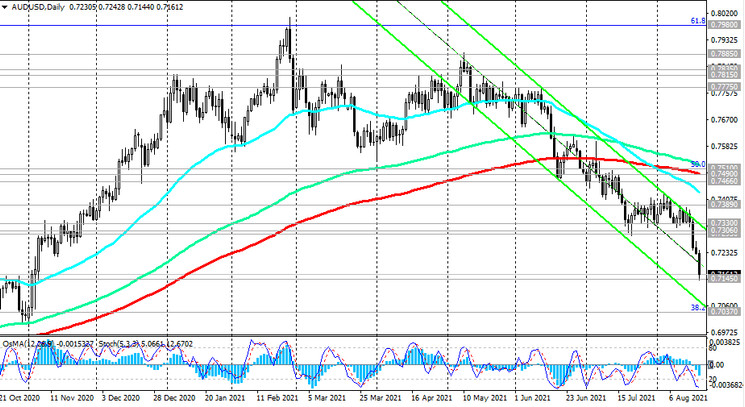Although Fed Chairman Jerome Powell, who spoke on Tuesday, did not speak out on monetary policy issues (most of his speech was devoted to the topic of the continuing spread of the coronavirus, which carries the threat of lockdowns and a new economic slowdown), the dollar nevertheless strengthened significantly on Wednesday and during today's Asian session.
The publication yesterday evening of the minutes from the July Fed meeting still had a negative impact on investor sentiment, which led to a sharp drop in stock indices, commodity prices and the strengthening of the dollar.
In the minutes, in addition to concerns about the threat to the economy from the coronavirus, it was also reported that the Fed leaders discussed the possibility of starting to reduce the volume of asset purchases by the end of the year.
Although the planned start of the reduction of the quantitative easing program will not be a harbinger of a rate hike, market participants considered this information as a signal to actively buy the dollar and sell high-yielding stock market assets.
The minutes reported that, despite significant growth rates, employment did not reach the required level for it to be necessary to start raising the interest rate.
Market participants are now assessing the likely cuts in stimulus measures from the US Federal Reserve and an increase in the incidence of Covid-19. Many investors have become cautious, fearing that the rise in coronavirus cases in the US and other countries will sharply slow down the economic recovery again, as the Fed prepares to start scrapping its bond buying program.
The DXY Dollar Index, which tracks the dollar against a basket of 6 major currencies, has risen nearly 1% since the start of this week, returning to late March and mid-November levels.
The weekly US jobless claims data will be published today at 12:30 (GMT), giving investors a fresh idea of the pace of the economic recovery. Economists suggest that initial filings fell last week to a new pandemic low (363,000 versus 375,000 in the previous week), indicating an improvement in the labor market.
Since the end of May, the number of initial jobless claims has fluctuated between 368,000 and 424,000. This is above the pre-crisis level, albeit below the highs reached at the beginning of the pandemic. In 2019, before the Covid-19 pandemic began, the average weekly initial filings were 218,000.
If the data on the number of jobless claims is confirmed or turns out to be better, then the dollar will receive a new stimulus for further strengthening against the background of increased expectations of the Fed's actions in the direction of reducing the volume of the QE program.
Meanwhile, after the release of the FRS minutes, the dollar, as we already know, strengthened, while commodity prices and quotes of commodity currencies continued their recent decline. Forecasts that the slowdown in economic growth in China will affect the demand for raw materials and industrial materials has increased the pressure on the commodity market. So, futures for Brent crude oil fell by about 3.5%, below $ 66.00 per barrel, the lowest level since May. Copper futures, which serve as an indicator of the health of the global economy as the metal is widely used in construction and manufacturing, fell 2.6%, below $ 4.00 a pound of weight. Also, prices for iron ore fell sharply, of which Australia is the largest exporter. The main export goods of Australia are coal (about 10% of exports), oil and products from it, liquefied gas, gold, iron ore.
Australia is also considered the world leader in uranium reserves (about 35% of total production) and has large reserves of lead, zinc and nickel.
Thus, the fall in commodity prices had the most negative impact on the Australian dollar. AUD / USD is declining for the 4th day in a row today, hitting a 9-month low at 0.7145, under the double pressure of a weaker AUD and a stronger USD. At the time of this posting, AUD / USD is traded near 0.7160 mark, 200 pips below this week's opening price.

Very encouraging data from the Australian labor market came out this morning: the employment level in July increased by 2.2 thousand (the forecast assumed a sharp decline in the indicator by 46.2 thousand), while the unemployment rate fell from 4.9% to 4.6 %, which also turned out to be better than analysts' forecasts, who had expected growth to 5%. However, these data did not provide significant support for the AUD. Besides, yesterday there were not the most confident data on the level of salaries in Australia. Thus, the wage index at the end of the 2nd quarter of 2021 slowed down to +0.4% from +0.6% in the 1st quarter, although it accelerated from +1.5% to +1.7% (in annual terms), which turned out to be worse than the forecast +1.9% y / y.
Well, since many economists expect a further strengthening of the US dollar on expectations of a soon curtailment of the Fed's QE program, a further fall in AUD / USD is most likely, although periods of remission of this "patient" also are not excluded.





